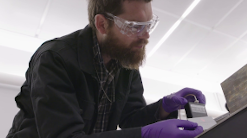Journal Thread #2 / Prompt 2 - How Close?
Watch the NIST Role Models discuss the importance of standardization, then consider how you would handle measurement in several experiments.
Teacher Tips!
Many activities have a teacher view and a student view, and teachers can switch between those views by clicking the blue button in the upper-right. Students will not see this option - only teacher accounts see both views. The teacher view will start with overview text, if available, to frame the activity and get you started. This view will also have teacher tips and suggested answers to student questions spread throughout the activity. The teacher text interleaved with student-facing text will be in italics and should appear as a different color on your screen. Teacher tips are designed to help you deliver a learning experience that is best suited for your classroom.
Printing Reminder
Whichever view you see on your screen is what will print. You can print this activity without teacher tips by selecting the student view, or print with teacher tips by switching to teacher view. Simply use the standard print function available for your web browser. No extra steps are required.
Title of Activity: Journal Thread #2 / Prompt 2 - How Close?
Brief Description: Students consider how the desired degree of precision varies by the stated goal of the project or research.
Target Grade Level: Grades 8-12
Discipline or Course: Physical Science
Estimated Time Required: 20 minutes
Individual / Partner / Group Work: Individual
Key Vocabulary:
- Precision
- Tolerance
- Error bar
Teacher Prep:
This journal prompt asks students to think about the idea that different levels of precision are needed for different tasks. The options include measurements of length, concentration, time, and energy. To understand the graph, provide concrete examples.
Possible Rubric
| Area | Novice | Average | Advanced |
| Constructing Arguments | Does not identify a measurement unit | Makes a vague reference to a measurement unit | Identifies a measurement unit with support |
| Communicating Information | No discussion of precision | Mention of precision without supporting arguments | Specific references to precision and clear supporting arguments |
| Identification of arguments based on evidence | No discussion of importance of precision | Precision defined or described without examples | Precision defined with examples   |
STUDENT CONTENT BELOW
Watch the NIST Role Models discuss standardization.
Before scientists begin any research, they think about how they will define “success.” You start with an expectation (a hypothesis). Then you think about how close your data would have to be in order for you to feel comfortable using that data to argue that you were right.
Imagine you were investigating each of the following questions. What measurement would you use? How close would your measurement have to be in order for you to feel comfortable arguing that your hypothesis was correct? Frame your argument as: “I believe that (the hypothesis) is supported because…”
- Using home compost will increase the growth of my bean plants in the third week of growth.
- Vitamin D in specified doses shortens recovery time from influenza in adolescents.
- Black roofing materials reduce the energy requirements for home heating in northern states.




